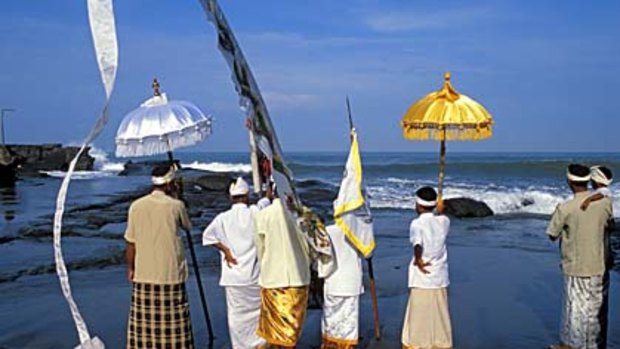
Ritual ... a traditional pre-Nyepi purification ceremony.Credit: AFP
While others flee the silence of Nyepi, Carolyn Parfitt finds it an excellent time to be in Ubud.
"SOMEONE forgot to tell the crowing roosters and cooing pigeons that today is the Day of Silence," I wrote in my diary while in Ubud. In the eerie hush of Nyepi, Bali's Hindu New Year's Day, their calls hung rudely in the air.
Leading up to this significant day of purification, we met other tourists heading to Lombok or other nearby Muslim regions in order to avoid it. But, having experienced Nyepi before, we're fond of it. Friends who live in Bali say it's their favourite day of the year.
OK, you have to stay in your hotel for the day, listening to the strange, rare silence of a Bali without motorbikes, tooting horns, construction work or recorded music, but the staff in many hotels and villas will make sure you don't starve. Where's the hardship in having nothing more to do for a day than reading and writing, snoozing and being fed? You can even take a dip in the pool if you're quiet.
Besides, it's worth being in Bali to see the preparations leading up to Nyepi. A frisson of excitement pervades the place as the people of the villages put the finishing touches on their "ogah-ogah", the giant papier-mache monsters that represent the evil spirits to be driven out of Bali by the ritual.
Wayan, the driver who took us from Padangbai to Ubud, said he had spent an hour or so each afternoon for the past month making ogah-ogah with his friends. Much discussion went into who would make the head or who would make the hands; then they sat together on a grassy patch and set to work, chatting all the while.
Whole villages participate in the preparations for Nyepi but making ogah ogah is mostly the province of the young men and boys. They fashion their monsters in the shape of characters from Hindu mythology as well as more contemporary images, sometimes adding flashing green lights for eyes. In A Short History of Bali: Indonesia's Hindu Realm, Robert Pringle reports that at the first Nyepi after the Kuta bombings (2002), an ogah-ogah representing one of the accused terrorists, Amrozi, made an appearance. "Perched on his shoulder was the demon-sorceress Rangda, goading him to do unspeakable things," Pringle wrote.
Balinese women spend the days leading up to Nyepi making offerings, shopping in the markets for food and preparing copious amounts of it ahead of time. No cooking is to be done on Nyepi; no fires or even cigarettes lit; no electricity switched on. Even the airport is closed. People are required to stay at home or in family compounds and the streets are monitored by wandering "pecalang" village wardens.
Before Nyepi arrives, in a sacred rite called "melasti", lines of people in beautiful traditional costumes head for the rivers and sea, where they symbolically wash small statues that represent their gods and ancestors. Later, the temple grounds are full of people in prayer.
As the sun starts setting on the eve of Nyepi, a din begins. People bang on tin pots and pans, drums and anything else that will make a racket, drawing the attention of the evil spirits to the offerings made to appease them. A procession of the ogah-ogah starts wending its way around the streets.
Accompanied by recorded gamelan music, teams of people carry their huge, lurching monsters on bamboo stands, thrilling the crowds.
We secure a clear view by following a trail of Balinese up the stairs of a high platform at the front of the main temple, looking straight down into Monkey Forest Road as the parade approaches. It takes about three hours for all the ogah-ogah to pass.
Afterwards, the streets are quiet again but not nearly as quiet as they will be tomorrow - when Bali turns off the noise and catches its collective breath.
Trip notes
Getting there
Jetstar flies from Sydney to Denpasar, Bali, priced from $757 return. 131 538, jetstar.com/au.
Staying there
Padangbai in eastern Bali is the port for Bali-Lombok ferries. Puri Rai Hotel has two-bedroom villa stays priced from $US134 ($134) a night and can arrange for a car and driver. +62 361 8528521, puriraihotel.com.
Observing there
Nyepi falls on March 5 this year, the day after the new moon and the start of the Saka lunar year of 1933.
More information
balitourismboard.org; balitrips.net.
Sign up for the Traveller Deals newsletter
Get exclusive travel deals delivered straight to your inbox. Sign up now.